

Three Ways to Increase Student Engagement in Reading. The research is clear: If a student is not motivated to read and is not engaged in the text, all of the strategy instruction a teacher might provide may be for naught (Guthrie and Klauda, 2014; Ivey, 2014; Wanzek et al, 2014).

That is why it is critical that we make reading meaningful so that students make meaning out of what they are reading and become lifelong readers. The following three activities are excellent beginnings for increasing reading engagement. 1. Best of Teacher HELPLINE!: 6 Interactive Reading Strategies to Boost Student Engagement. Reading aloud is an important skill, but it can be all too easy for us to allow this activity to become mundane and detached by repeatedly conducting “popcorn reading” or simply reading aloud to the class and asking students questions.
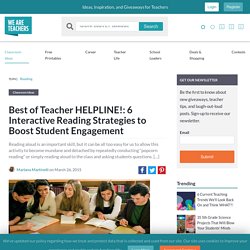
Deb, a 9th grade english teacher, asked the WeAreTeachers HELPLINE! For recommendations on reading strategies to promote student engagement. Read on to learn six strategies for interactive reading that are recommended for teachers, by teachers. We’ve also compiled corresponding videos for each strategy —if one strikes your fancy, check out the video to see it in action! 1. NAEP reading - Reading Assessment. Reading Games. Active Reading Strategies: Remember and Analyze What You Read. Choose the strategies that work best for you or that best suit your purpose.

Ask yourself pre-reading questions. For example: What is the topic, and what do you already know about it? Why has the instructor assigned this reading at this point in the semester? Identify and define any unfamiliar terms.Bracket the main idea or thesis of the reading, and put an asterisk next to it. Pay particular attention to the introduction or opening paragraphs to locate this information.Put down your highlighter. ELA Standards1. Seven Strategies to Teach Students Text Comprehension. 1.

Monitoring comprehension Students who are good at monitoring their comprehension know when they understand what they read and when they do not. They have strategies to "fix" problems in their understanding as the problems arise. Research shows that instruction, even in the early grades, can help students become better at monitoring their comprehension.
Teaching Methods for Inspiring the Students of the Future. Reading Terms Flashcards. Raise a Reader: A Parent Guide to Reading for Ages 3-5. Study Skills: Strategies for Reading Textbooks. Reading textbooks may not be fun, but being able to is important.
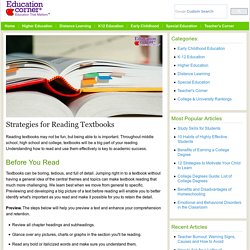
Throughout middle school, high school and college, textbooks will be a big part of your reading. Understanding how to read and use them effectively is key to academic success. Before You Read Textbooks can be boring, tedious, and full of detail. Jumping right in to a textbook without having a general idea of the central themes and topics can make textbook reading that much more challenging. Preview. Review all chapter headings and subheadings.Glance over any pictures, charts or graphs in the section you'll be reading.Read any bold or italicized words and make sure you understand them.Read the chapter summary.Review any end of chapter questions.
Question. While You Read The following strategies will help you maximize your comprehension and retain information while reading textbooks. Reflect. How to inspire every child to be a lifelong reader. 7 Reading Readiness Apps for Special Needs Students. What is reading readiness?

The dictionary defines it as the point when a child transforms from being a non-reader to being a reader. But this definition leaves out the concept that reading readiness may actually begin in the womb. Watch Annie Murphy Paul's TED Talk to learn more about what is called fetal origins. In another vein, as Maryanne Wolf writes in Proust and the Squid: The Story and Science of the Reading Brain, "We were never born to read. " Getting ready to read takes years of informal exposure to language and print in a myriad of ways.
How can we use tech to support the special-needs population? Top 12 Websites For Children With Learning Disabilities. Capella University MS Ed - Special Education Teaching Image Source As many educators, parents, and families know, having a learning disability doesn’t make a child any less smart than his or her peers. In fact, it often means that the child is as smart or smarter but their brain just works differently because it’s neurological process. People with learning disabilities have a biological brain make up which counterintuitively functions to typical memory, reasoning, planning, organizational, and attention tasks. Parents and special education teachers often have difficulty finding new tactics to provoke a love for learning in children with learning disabilities. Is it Too Late to Help my Middle/High School Student with Reading? Middle and high school reading: Tips from the pros.
Who knows better than teachers and literacy coaches what students need to succeed in middle and high school reading?
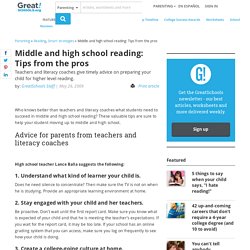
These valuable tips are sure to help your student moving up to middle and high school. High school teacher Lance Balla suggests the following: 1. Understand what kind of learner your child is. 14 Activities That Increase Student Engagement During Reading Instruction. ***This content is based on a webinar presented by Reading Horizons Reading Specialist, Stacy Hurst.*** Research shows that students whose teachers spend too much time talking are less likely to be engaged during classroom instruction.
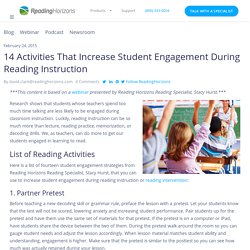
25 Activities for Reading and Writing Fun. These activities have been developed by national reading experts for you to use with children, ages birth to Grade 6.

The activities are meant to be used in addition to reading with children every day. In using these activities, your main goal will be to develop great enthusiasm in the reader for reading and writing. You are the child's cheerleader. Six Games for Reading. Here are six games parents or tutors can use to help young readers practice word recognition, spelling patterns, and letter-sound knowledge.
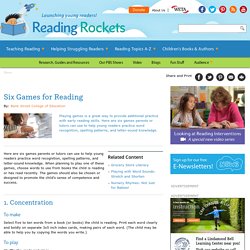
When planning to play one of these games, choose words to use from books the child is reading or has read recently. The games should also be chosen or designed to promote the child's sense of competence and success. 1. Concentration. What I Do for Guided Reading. Guided Reading Lesson Plan Template. Fluency: Instructional Guidelines and Student Activities. Guidelines for instruction Provide children with opportunities to read and reread a range of stories and informational texts by reading on their own, partner reading, or choral reading.Introduce new or difficult words to children, and provide practice reading these words before they read on their own.Include opportunities for children to hear a range of texts read fluently and with expression.Suggest ideas for building home-school connections that encourage families to become involved actively in children's reading development.Encourage periodic timing of children's oral reading and recording of information about individual children's reading rate and accuracy.Model fluent reading, then have students reread the text on their own.
What students should read Fluency develops as a result of many opportunities to practice reading with a high degree of success. A New Model for Teaching High-Frequency Words. We have visited many schools to observe intervention lessons and core reading instruction. For years we have been struck that even schools embracing research-based reading instruction teach high-frequency words through rote memorization. It is as if the high-frequency words are a special set of words that need to be memorized and can’t be learned using sound–symbol relationships. A number of years ago, a teacher we respect enormously asked for help because many of her Tier 2 students and all of her Tier 3 students in first and second grades were failing to learn high-frequency words, even though they were progressing in their phonics lessons. The Key to Comprehension: Teaching Reading Strategies.
Thirty-one percent of fourth-graders in the United States failed to achieve basic skills on the 2015 National Assessment of Educational Progress reading test. Thirty-six percent demonstrated reading skills at or above the proficient level. In a review of research on comprehension instruction, the significant number of students who do not understand grade-appropriate material “is all the more troubling given that we know more than ever about teaching reading effectively,” according to the National Reading Technical Assistance Center. “The importance of understanding the nature of good reading instruction in the primary grades cannot be overstated.” Research has shown a strong correlation between learning to read early and later achieving academic success. Educators can equip beginning readers with the tools needed to help them think about and analyze text as they read.
The panel conducted an extensive review of more than 800 relevant studies in a 20-year span. Advance Your Teaching Career. Station Rotation: Differentiating Instruction to Reach All Students. Collaborative Reading: Building Successful Readers Together. 25 Reading Strategies That Work In Every Content Area. 25 Reading Strategies That Work In Every Content Area by TeachThought Staff Reading is simply a sequence of symbol interpretation. By understanding that letters make sounds, we can blend those sounds together to make whole sounds that symbolize meaning we can all exchange with one another. By mastering the symbols and their most common contexts, reading becomes a practice in thought–less about decoding and more about understanding.
Without getting too Platonic about it all, reading doesn’t change simply because you’re reading a text from another content area. Science content can often by full of jargon, research citations, and odd text features. Hooked on Phonics.